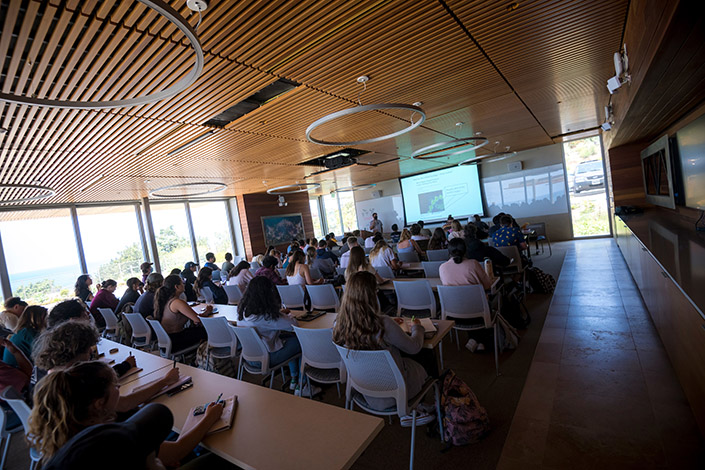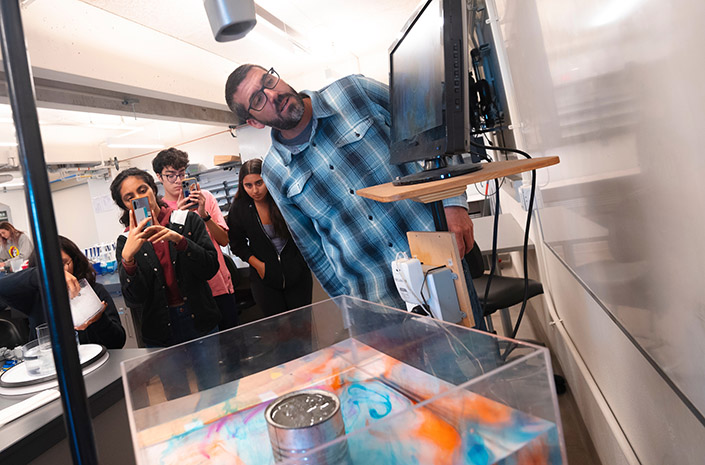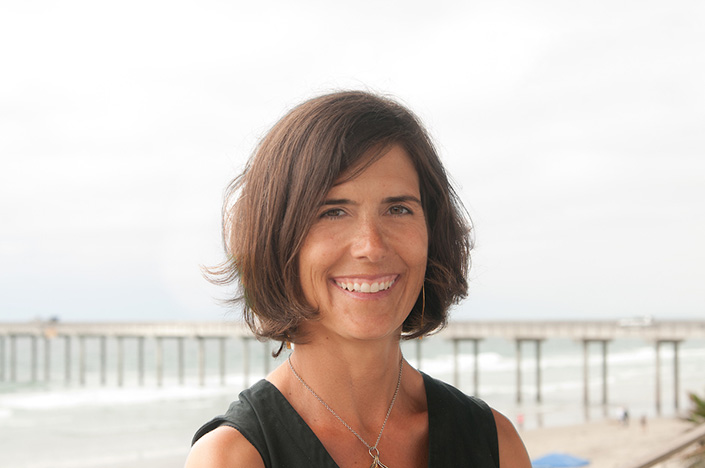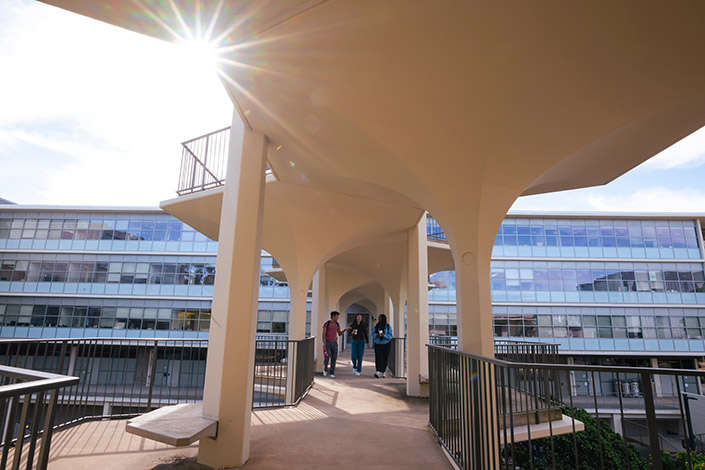UC San Diego Launches New Graduation Requirement, Bolstering Climate Change Education
Rolling out this fall, the Jane Teranes Climate Change Education Requirement honors the memory of beloved professor, climate champion
Story by:
Published Date
Story by:
Topics covered:
Share This:
Article Content
California Politics. Literature and the Environment. Natural Disasters. These are just a few of the courses at UC San Diego that will fulfill its new climate change education requirement—the first of its kind at a major public university and the first within the University of California system.
Beginning this fall, UC San Diego is implementing the Jane Teranes Climate Change Education Requirement (JTCCER), an initiative designed to ensure that undergraduates across all majors on campus are equipped to understand and address climate change. The new graduation requirement is named in honor of the late Jane Teranes, a beloved teaching professor at Scripps Institution of Oceanography and advocate for climate education at UC San Diego.
The JTCCER requires all incoming first-year students enrolled in bachelor’s degree programs to complete a one-quarter course from a list approved by the UC San Diego Academic Senate. This academic year, 33,800 undergraduate students are enrolled at UC San Diego, including more than 7,000 first-year students who will need to meet the new requirement.
The program was thoughtfully designed to ensure that approved climate courses align with general education and major-specific requirements, allowing students to meet the mandate without increasing their overall workload. Incoming transfer students are exempt from the new requirement but are welcome and encouraged to enroll in one of the approved courses.
“UC San Diego has a long history of leadership in climate research and education, and the Jane Teranes Climate Change Education Requirement marks a new path forward,” said Chancellor Pradeep K. Khosla. “Whether undergraduates are majoring in STEM, the humanities, arts, social sciences or any other field, this requirement will equip them with a strong understanding of climate change and how they can contribute to meaningful solutions.”
More than 40 courses that fulfill the new requirement are available for the 2024-25 academic year, with additional offerings expected in the future. Scripps Institution of Oceanography offers the largest number of approved JTCCER courses, with numerous options also provided by departments including Anthropology, Political Science, Global Health, Visual Arts, and others.
Developing the new requirement
A climate change education requirement for undergraduates was initially recommended by UC San Diego’s Campus Committee on Climate Change, leading to the formation of a joint Senate–Administration Workgroup on Climate Change Education for All in 2022.

Teranes and Muir College Provost Wayne Yang served as co-chairs of the inaugural workgroup, which included 10 other members. To build a strong foundation for the proposal, the workgroup engaged with a broad range of faculty, administration, and students across campus.
They drew inspiration from UC San Diego’s Diversity, Equity and Inclusion (DEI) requirement, which was implemented in 2011 and mandates that all undergraduates take and pass at least one approved DEI course before graduating. While there is no single template, approved DEI courses are designed to critically engage students with topics on race, power, and anti-racist efforts that meaningfully challenge structural racism.
“We took the best learnings from the DEI requirement—which Jane was also involved with—ensuring that the requirement does not add additional time to degree for students,” said Yang. “The climate requirement incentivizes and encourages faculty to integrate climate change education into their upper division courses, and thus deepens the curriculum by focusing on what students can actually do about climate change from their disciplines. Importantly, it treats climate change as an interdisciplinary issue.”
The workgroup determined that a course must focus at least 30% of its content on climate change to be eligible for approval to satisfy the JTCCER. These approved courses invite students to examine the complex nature of climate change and potential solutions—such as mitigation, adaptation, and justice—from a variety of perspectives, including scientific, technical, cultural, psychological, political, and economic.
“Hypothetically, we could envision that engineering students might want to take a course in their major that lets them think about how to build sustainable widgets, while political science students might seek courses in their major that explore policy implications related to sustainability,” said Sarah Gille, a Scripps professor and physical oceanographer who served on the workgroup. “Other students might want to take courses outside their major for a broader view of the world.”
Honoring a climate champion
Amid the effort to finalize the proposal, Teranes unexpectedly fell ill and passed away in July 2022. Devastated by the loss of their colleague and friend, the workgroup members felt it was only fitting to name the climate requirement in her memory.

“Jane had been an integral part of both getting the idea on the table and then co-chairing the workgroup, so we quickly reached a consensus to name the requirement in her honor,” said Gille. “She had a deep understanding of how to teach climate to students, and her absence leaves a significant void. This new requirement is just one way of paying tribute to her lasting impact on campus.”
Indeed, Teranes was a changemaker in climate education and a champion for increasing diversity in STEM, particularly in the geosciences. Over a career spanning more than two decades at UC San Diego, she designed and led several programs to support undergraduates in science. These include the Environmental Systems (ESYS) program, which she directed; the Scripps Geosciences Educational Opportunities (Scripps-GEO) program for San Diego community college students; and the Scripps Undergraduate Research Fellowship (SURF), a summer internship program geared toward underrepresented students.
Additionally, Teranes helped establish the climate change studies minor at UC San Diego in 2019, and she lent her expertise to developing the UC-led “Bending the Curve” course series on climate solutions. She also contributed to the Teaching Climate Across the Curriculum program, which provided faculty with resources to add climate-related units to their courses.
Initially trained as a paleoclimatologist, Teranes later transitioned her career to focus on education. In a 2019 video interview, she reflected on her motivations for making the shift and expressed gratitude for her work with undergraduates.
“Working in climate change and understanding the facts about climate change can sometimes feel overwhelming,” Teranes said. “Working with undergrads makes me feel like I’m doing something useful and I see the potential for solutions, and that gives me hope.”

A step forward
Recognizing the importance of Teranes’ latest climate education effort, the Senate–Administration Workgroup finalized the JTCCER proposal after Jacobs School of Engineering Professor Jan Kleissl stepped in as co-chair. The Academic Senate officially approved the new graduation requirement at a Representative Assembly meeting in October 2023, with a program review set for five years after its implementation.
Scripps Oceanography Professor Dan Rudnick, who chairs the JTCCER Committee responsible for approving courses that fulfill the requirement, said he was pleased to see the proposal succeed. He noted that it effectively incorporates a range of interdisciplinary courses that address at least two of the four key criteria for teaching climate change. These criteria are: providing students with the scientific background to understand climate change, exploring the societal impacts and social dimensions, inviting ideas for potential solutions, and incorporating hands-on projects or experiential learning opportunities.
Most important to Rudnick is that the new requirement adopts a student-centered approach. In short, it shouldn’t make graduation more difficult—hence the decision to exempt transfer students.

“It’s a big deal to add any new requirement, so we carefully considered the design of this program. It was really important to me that students would have as many course options as possible so this would not be a burden and they would ultimately graduate with a deeper understanding of climate change,” said Rudnick. “The resulting program represents a fantastic team effort and is far beyond my expectations.”
The JTCCER represents the latest example of UC San Diego’s leadership in climate science. Scripps Oceanography and several other departments already offer a variety of climate-related degree programs at the undergraduate and graduate levels. The new requirement expands climate learning opportunities for non-majors, and both Rudnick and Gille think it could serve as a model for other large public universities.
So far, only a few other higher education institutions have introduced graduation requirements in climate or sustainability, and those efforts have largely been led by private universities or small liberal arts colleges.
“We set up the new requirement with the best intentions to make sure that UC San Diego produces graduates who are ready to meet the challenges of a changing climate, regardless of their field of study,” said Gille. “We need everyone engaged in this work, and we hope the JTCCER program will inspire others to follow suit.”
It also recognizes a climate educator whose legacy continues to resonate both on campus and beyond.
“Jane was the brains, the muscle, and the heart behind the new requirement,” said Yang. “I’m proud that our workgroup has been able to carry her vision forward.”
Learn more about research and education at UC San Diego in: Climate Change
You May Also Like
Engineers Take a Closer Look at How a Plant Virus Primes the Immune System to Fight Cancer
Technology & EngineeringStay in the Know
Keep up with all the latest from UC San Diego. Subscribe to the newsletter today.




